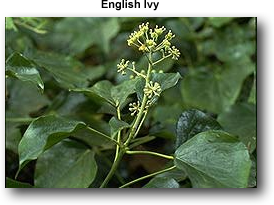English Ivy (Hedera helix)
Also known as Common Ivy
⚠️ IMPORTANT SAFETY WARNING
English Ivy is TOXIC to humans and pets. All parts of the plant contain poisonous compounds.
Toxic Compounds:
Saponins (hederin and hederagenin), pentacyclic terpenoids
Symptoms if ingested:
Nausea, vomiting, diarrhea, convulsions, skin rashes
Keep away from children and pets. Consider pet-safe alternatives if you have animals.

Hedera helix (from Ancient Greek meaning "twist, turn") is a species of ivy native to most of Europe and southwest Asia. Despite its toxicity, it's valued for its vigorous growth and air-purifying qualities.
🌱 Air Purification: English Ivy is excellent at removing indoor air pollutants, making it popular for indoor cultivation despite safety concerns.
Plant Description
English Ivy is an evergreen climbing plant that can grow 20-30 meters high where suitable surfaces (trees, cliffs, walls) are available. It also grows as ground cover where there are no vertical surfaces. The plant holds onto surfaces using short adhesive rootlets.
The helix part of the name refers to the spiral patterns found in the leaves. The plant produces two distinct types of leaves depending on its growth stage and position.
Leaf Types & Growth Patterns
🌿 Juvenile Leaves
Shape: Palmately five-lobed
Size: 4-8 cm long
Petiole: 3-10 cm long
Location: Found on creeping and climbing stems
Appearance: Distinctive lobed shape, alternate arrangement
🍃 Adult Leaves
Shape: Unlobed and cordate (heart-shaped)
Location: Fertile flowering stems
Position: High in tree crowns or top of rock faces
Exposure: Full sun exposure
Function: Associated with reproductive phase
Flowers & Berries
🌸 Flowering
Season: Late summer to late autumn
Structure: 3-5 cm diameter umbels
Color: Greenish-yellow
Nectar: Very rich, important food source for bees and insects
Pollination: Attracts various pollinators
🫐 Berries & Seeds
Appearance: Small black berries
Ripening: Late winter
Wildlife Value: Important food for many birds
Toxicity: Poisonous to humans
Dispersal: Seeds spread by birds eating fruit
Cultivation & Uses
🌱 Ornamental Cultivation
English Ivy is widely cultivated as an ornamental plant with numerous cultivars selected for various attractive traits:
- • Yellow variegated leaves
- • Deeply lobed leaf varieties
- • Purple-stemmed cultivars
- • Slow-growing dwarf varieties
- • Compact forms for containers
- • Cold-hardy selections
🌍 Invasive Species Concerns
In North America, English Ivy has become naturalized and is sometimes considered an invasive species, especially in the Pacific Northwest where the climate is similar to its native European habitat. Check local regulations before planting outdoors.
Indoor Care Guide
☀️ Light
Bright, indirect light is ideal. Can tolerate low light conditions but growth may slow. Avoid direct sunlight which can scorch leaves.
💧 Watering
Keep soil consistently moist but not waterlogged. Allow top inch to dry between waterings. Reduce watering in winter.
🌡️ Temperature
Prefers cool to moderate temperatures (60-70°F). Very cold-hardy outdoors but keep away from heat sources indoors.
💨 Humidity
Moderate to high humidity preferred. Mist regularly or use humidity trays. Good air circulation prevents fungal issues.
🌱 Support
Provide moss poles, trellises, or allow to trail. Adhesive rootlets will attach to rough surfaces naturally.
✂️ Pruning
Regular pruning maintains shape and encourages bushier growth. Always wear gloves when handling due to toxicity.
Safety Considerations
🚫 Household Safety
Pet Safety
- • Keep out of reach of cats and dogs
- • Monitor pets for chewing behavior
- • Consider pet-safe alternatives
- • Know emergency vet contact info
Child Safety
- • Place in areas inaccessible to children
- • Teach children not to touch or taste
- • Clean up fallen leaves promptly
- • Consider removing if safety is a concern
🧤 Handling Precautions
Always wear gloves when pruning, repotting, or handling English Ivy. Some people may develop skin rashes from contact with the plant. Wash hands thoroughly after any contact.